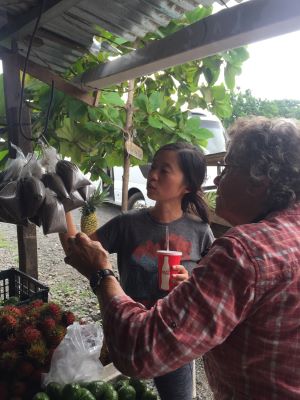by Gisele Giorgi
 I’m always a little off kilter when I get back from Costa Rica. Why do people look at me weirdly when I say “Hola?” Why does everyone seem to speak only one language? Where’s the jungle outside my door? Where did all the frogs go? I know this is my house, but is it? It seems so odd… Why is everyone in this giant supermarket so grumpy? Has the sky always been that color?Each year, before the trip, I ask myself: why all this fuss? Why do we take all the time and expense, in this day and age of climate change, to fly so far away in a polluting, costly (albeit fun) airplane? Why not do something in our own backyards? We have plenty of gorgeous nature, after all.
I’m always a little off kilter when I get back from Costa Rica. Why do people look at me weirdly when I say “Hola?” Why does everyone seem to speak only one language? Where’s the jungle outside my door? Where did all the frogs go? I know this is my house, but is it? It seems so odd… Why is everyone in this giant supermarket so grumpy? Has the sky always been that color?Each year, before the trip, I ask myself: why all this fuss? Why do we take all the time and expense, in this day and age of climate change, to fly so far away in a polluting, costly (albeit fun) airplane? Why not do something in our own backyards? We have plenty of gorgeous nature, after all.
Then, each year, once I’m there, I remember. I get captivated by the charm of Costa Rica. The abundance of plants and animals and bugs and water. The relaxed, friendly people. The pure air, pure water, fresh food. The magic of it all. And, omg, the fruit. The FRUIT! If I could, I’d be a fruitarian. So, Costa Rica is party central for me, food-wise. You truly haven’t tasted pineapples if you’ve only eaten them in California. Then there’s cas and mamones and guanabana and… Don’t ask me to translate or explain, we don’t have them here.
So, here’s one answer to why I travel so far: it’s good for me, as well as for our students, to be thrown into a very different environment. I’m surely not the first to figure that out, but somehow, being a very normal human, I keep forgetting that lesson. So each dose helps. It’s a bit like a vaccine for my ongoing case of the blinders. Each piece of Costa Rica that soaks in helps to develop me more fully. Travel calls to and strengthens wonderful sides of me that are undernourished in my current home, delightful as it is. I mean, did I mention the fruit?!
It takes me at least a week to re-orient myself to life in California. But I think the Costa Rica immersion lingers in me, more so each time I visit. An ever more solid piece of me recognizes and rejoices when I come across a “hola.” I still think bats are cute, now, even back in the U.S.A.
On a hot day, I remember how the breeze felt on the wide Tarcoles river, especially at the point where it meets the ocean and you see water all around you. When somebody is being charming and pushy, and putting themselves in danger, I think back to the wild coati who was determined to board our bus. When I’m struggling with my immediate world, I can remember the bat I held. He was so clumsy in the weird world of our lab, but, once able to fly away, he was so full of power in the air. And then there’s those red-eyed tree frog embryos: they all blithely developed feathery gills and beating hearts, while under a microscope in our lab. Fortunately, they were still attached to their original leaf, and got to finish out their growth in a lovely pond.





